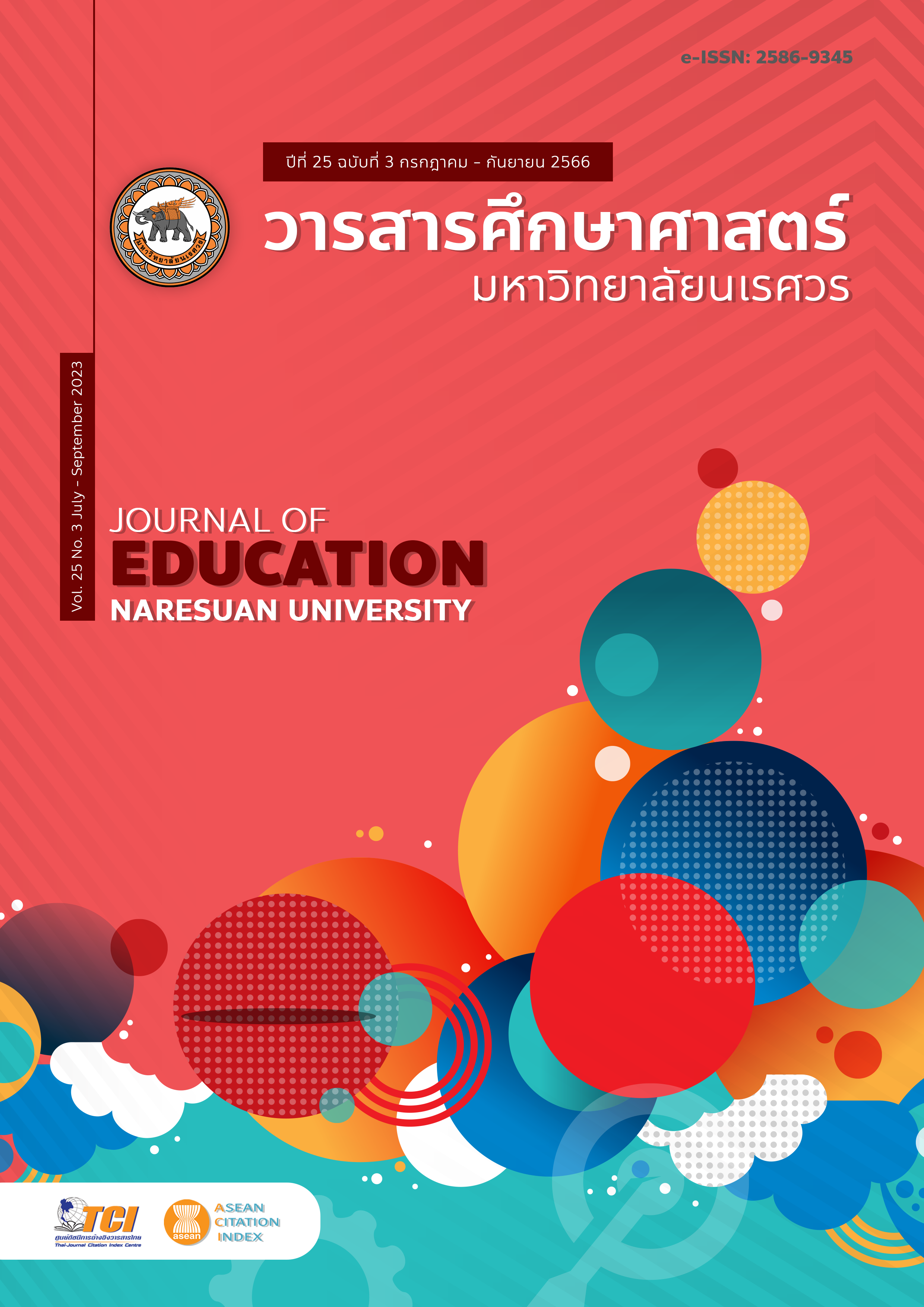THE DEVELOPMENT OF BLENDED INSTRUCTIONAL MODEL IN ART EDUCATION BASED ON DESIGN THINKING AND PRACTICAL ART LEARNING INTEGRATED WITH COGNITIVE TOOLS TO ENHANCE CREATIVE THINKING AND ARTWORKS OF HIGH SCHOOL STUDENTS การพัฒนารูปแบบการเรียนการสอนแบบผสมผสานวิชาศิลปศึกษาตามแนวทางการคิดเชิงออกแบบร่วมกับการเรียนศิลปะปฏิบัติที่บูรณาการเครื่องมือทางปัญญา เพื่อพัฒนาความคิดสร้างสรรค์ในการสร้างผลงานศิลปะของนักเรียนมัธยมศึกษาตอนปลาย
Main Article Content
Abstract
This research aims to create a model and study the model result the Development of Blended Instructional Model in Art Education Based on Design Thinking and Practical Art Learning Integrated with Cognitive Tools to Enhance Creative Thinking and Artworks of High School Students. Sample groups in this research were a class of 38 high school students learning Visual Arts. The research tools are questionnaires, interview forms, learning management patterns, online classrooms, evaluation forms of creative works and questionnaires from the students who learned within this model, quantitative analysis with descriptive statistic and t-test dependent analysis and qualitative content analysis. The research result found that: 1) The Development of Blended Instructional Model was composed of (1) blended arts learning activities, (2) learning sources, (3) communication/interaction to learning, (4) learning and teaching management, and (5) learning evaluation. Also, there were six steps of learning and teaching activities which are creating inspiration and knowledge acquisition, knowledge collection and access, thought-provoking and knowledge expansion, building up creative works, adapting and developing works and criticism and evaluation. 2) Experimental results of the blended instructional model showed that after learning through the Development of Blended Instructional Model in Art Education had average score significantly higher than previously at the statistical level of .05. Also Artworks of students had creativity score above the specified standard with an average value in the high level.
Article Details

This work is licensed under a Creative Commons Attribution-NonCommercial-NoDerivatives 4.0 International License.
The owner of the article does not copy or violate any of its copyright. If any copyright infringement occurs or prosecution, in any case, the Editorial Board is not involved in all the rights to the owner of the article to be performed.
References
Anderson, L. W., & Krathwohl, D. R. (2001). A taxonomy for learning, teaching, and assessing: A revision of Bloom’s Taxonomy of educational objectives. New York: Longman.
Bloom, B. S. (1972). Taxonomy of educational objectives. New York: David Mckay.
Bonk, C. J., & Graham, C. R. (2004). Handbook of blended learning: Global perspectives. San Francisco: Pfeiffer.
Brahmawong, C., Netprasert, S., & Sudasinsakul, S. (1977). Teaching media system. Bangkok: Chulalongkorn University Press. [in Thai]
Chalermsuk, N. (2019). Development of integrated teaching and learning models with learning practical skills with cognitive tools through cloud computing to strengthen thinking skills creating and creating works of art for high school students. Journal of Education Chulalongkorn University, 47(1), 84-102. [in Thai]
Charoenwongsak, K. (2004). creative thinking (6th ed.). Bangkok: Success Media. [in Thai]
Clark, G. A., Day, M. D., & Greer, W. D. (1987). Discipline-based art education: Becoming students of art.
The Journal of Aesthetic Education, 21(2), 129-196.
Gagne, R. M. (1965). The conditions of learning. New York: Holt, Rinehart and Winston.
Iga Setia Utami (2018). The Effectiveness of Blended Learning as an Instructional Model in Vocational High School. Journal of Education Science and Technology, 4(1),74-83.
Kaisang, J. (2013). An e-learning integrated teaching science based on the constructivist approach with intellectual tools to enhance knowledge generation of tertiary learners: from the form that present to use. Journal of Education, 41(4), 16-34. [in Thai]
Kangwarawut, C. (2014). Development of a learning and teaching model of Silapiwat through cloud technology to promote creative works according to the creative economy (Doctoral dissertation). Bangkok: King Mongkut's University of Technology North Bangkok. [in Thai]
Kanjug, P. (2015). Development of a passive learning model through Klaw technology for Encourage critical thinking and learning cooperation (Doctoral dissertation). Bangkok: King Mongkut's University of Technology North Bangkok. [in Thai]
Kanthanyalak, P. (2014). Development of integrated teaching and learning models by learning Solve joint problems and synaptic techniques to foster creative problem-solving abilities of teachers students. Veridian E-Journal, 7(3), 666-681. [in Thai]
Kemp, J. E. (1985). The instructional design process. New York: Harper & Row.
Koraneekit, P., & Klaisang, J. (2013). A blended e-learning model using online interactive learning notes to promote the curiosity and memory persistence of the students of faculty of education. Chulalongkorn University Journal of Education, 43(3), 66-83. [in Thai]
Mayer, R. E. (1983). Thinking, problem solving, cognition. New York: Freeman.
Marzano, R. J., Brandt, R. S., Hughes, C. S., Jones, B. F., Presseisen, B. Z., Rankin, S. C., & Suthor, C. (1988). Dimension of thinking: A framework for curriculum and instruction. Alexandria, VA: Association for Supervision and Curriculum Development.
Panmanee, A. (2003). Creative psychology of teaching and learning. Bangkok: Silk Fiber. [in Thai]
Phumhapinyo, S. (2016). Development of a blended learning model using intellectual tools in conjunction with infographic design processes to enhance visual and creative knowledge for art students (Doctoral dissertation). Bangkok: Chulalongkorn University. [in Thai]
Santrock, J. W. (2009). Educational psychology. Boston, Mass: McGraw Hill.
Torrance, E. P. (1962). Guiding creative talent. Englewood Cliffs, NJ: Prentice Hall.


